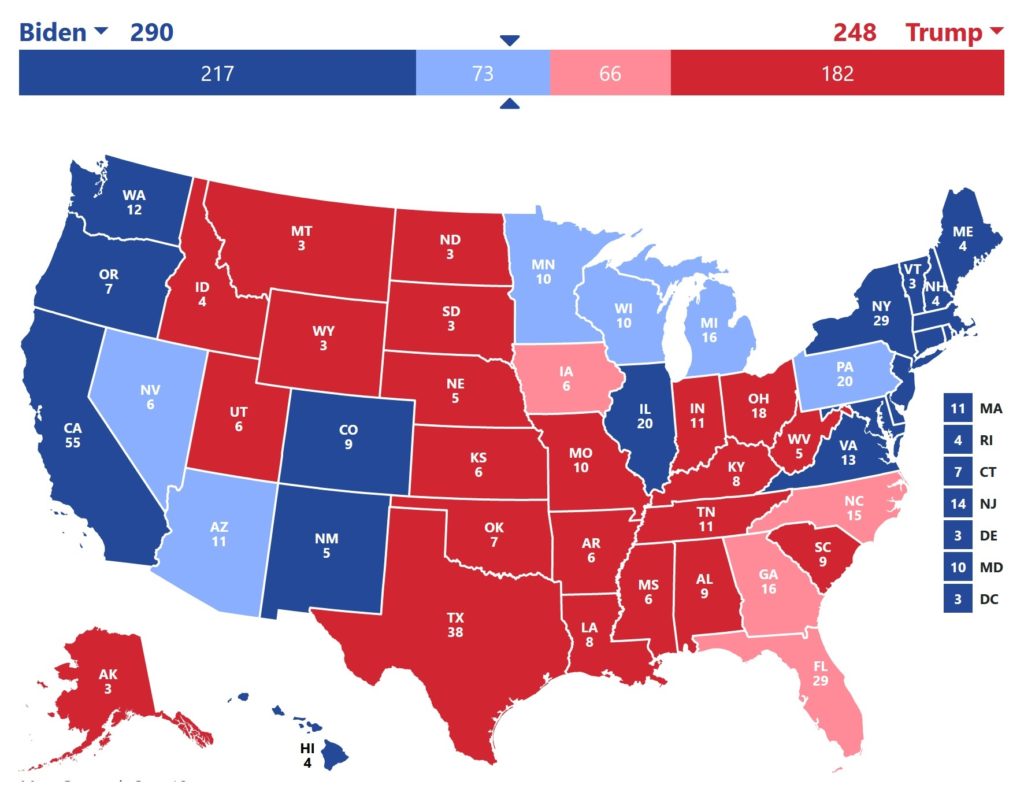It’s the final stretch. The bottom of the ninth. The last lap. The closing chapter. The happy ending. Or insert your own culmination idiom here.
Anyway, since we’re only two weeks away from Election Day, I revisited my election models for the Electoral College, the Senate, and the House.
Fair warning: My analysis yields slightly different results than I’ve been reading elsewhere. While I certainly find no fault with the more professional models used by others (538, Cook, Sabato, Politico, etc.), my mathematical models somehow seem to reflect my non-mathematical outlook – which, at the moment, resides somewhere between a default pessimism and a very cautious optimism. That said, my models take into account weighted polling data, but also consider the each state’s voting history, party control in each state, state demographics, 2018 election data, and few other factors.
Presidential Election
Here’s my current landscape map of the 2020 Electoral College (using 270toWin‘s build-your-own map feature):
While things have definitely moved in Democrats’ direction since I published my initial 2020 landscape post way back in December of 2018, the movement hasn’t been massive. My current analysis says that forty states are now baked. Biden has 217 solid Electoral votes (dark blue) to Trump’s 182 (dark red). Sure, some models show a few of those states (e.g. Texas, Kansas, Ohio) are still within reach for Biden. My model says otherwise.
Of the remaining ten in-play states, Biden is likely to win six of them (light blue) and Trump is likely to win the other four (light red). That split would give Biden a 290/248 win in the Electoral College.
All ten of these states, however, could move into the other camp – with varying probabilities of doing so within the next two weeks. Pennsylvania and Florida appear to be the states on each side most likely to move.
The good news? If my model holds, Biden wins. The win is largely the “Middle America” strategy I discussed in a February 2019 post with a focus on winning the Great Lakes states that currently lean toward Biden. Note that even if Biden loses any one of his “likely” states, he’d still be just over the threshold of the required 270 Electoral votes. Conversely, Trump needs to not only hold all four of his “likely” states, he needs to move at least two Biden states to his column.
The bad news? Nothing is over. Trump could still win or could at least get close enough that the election results get thrown into the courts and/or the House – which wouldn’t end well for anyone. A Biden blowout is possible, but it looks unlikely to me. A close Electoral College split is the more probable outcome.
U.S. Senate
I don’t understand the rosy predictions I see everywhere for Senate Democrats. Yes, Democrats will see a net gain of seats and things may be very slightly better for Democrats than they were when I discussed the Senate last month.
However, my model currently has the most probable outcome to be a 50/50 split – with the winning VP casting the deciding Senate votes. That wouldn’t be at all pretty regardless of the VP.
Democrats should flip Arizona, Colorado, Maine, and North Carolina; Republicans will likely flip Alabama. That D+3 net is the 50/50 split.
The best path Republicans have to retain their majority is to pull out a win in North Carolina – which is only recently a possibility after the NC Democratic candidate insisted on pulling out something himself. That’s right. Democrats could actually lose the Senate because one guy couldn’t keep his pants on. How 2020 is that?
The best paths Democrats have to secure a majority are through Iowa and/or Montana. Both are within reach but both are far from sure things.
The other races on some radars as potential R-to-D flips (South Carolina, Kentucky, Kansas, Texas, and both Georgia races) just ain’t happening in my model. In this regard, I sincerely hope that my model is wrong.
U.S. House
I didn’t need to do the math here, but I did. Democrats will easily retain control of the U.S. House. In fact, they’re likely to see a small net gain of 5-8 seats.
